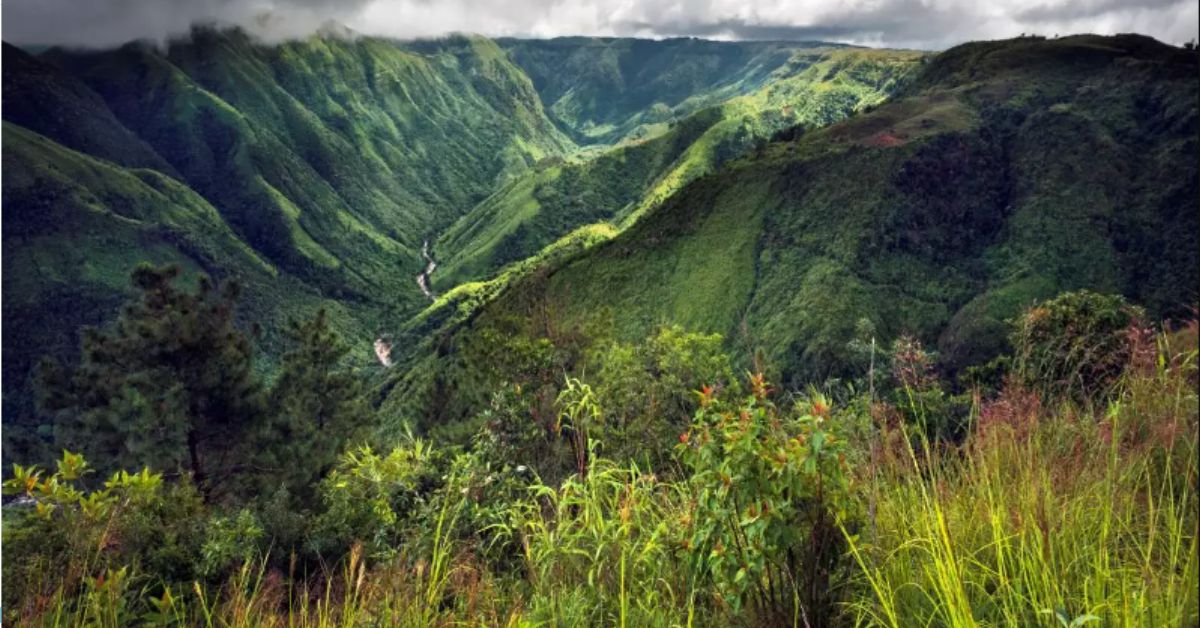Nestled in the lush hills of Meghalaya, Mawsynram stands as a testament to nature’s extraordinary power. Renowned as the wettest place on Earth, this picturesque village is a world apart, where rain is a constant companion. As you journey through mist-laden landscapes, you’ll encounter cascading waterfalls, emerald valleys, and the tranquil charm of traditional Khasi huts. Mawsynram isn’t just about the rain; it’s a place where nature’s resilience and the local community’s harmonious existence intertwine, creating a truly unforgettable experience.
How to reach:
- From Guwahati: The most common route involves a 4-5 hour drive covering approximately 170 kilometers. The journey offers scenic views of lush hills and charming towns.
- From Shillong: Located about 60 kilometers south, Mawsynram is a 2-3 hour drive away.
Transportation Options:
- Shared Cabs: A convenient and cost-effective option available from both Guwahati and Shillong.
- Private Taxis: Offers more flexibility and comfort for travelers.
Best time to visit:
Dry Season (October to April): This period offers pleasant weather with moderate temperatures, ideal for outdoor activities and sightseeing. Clear skies enhance visibility of the lush landscapes and waterfalls.
Monsoon Season (May to September): Mawsynram receives intense rainfall, transforming the region into a verdant paradise. While ideal for experiencing the village’s reputation as the wettest place on Earth, heavy rainfall might disrupt travel plans and outdoor activities.
Attractions:
Mawlyngbna:
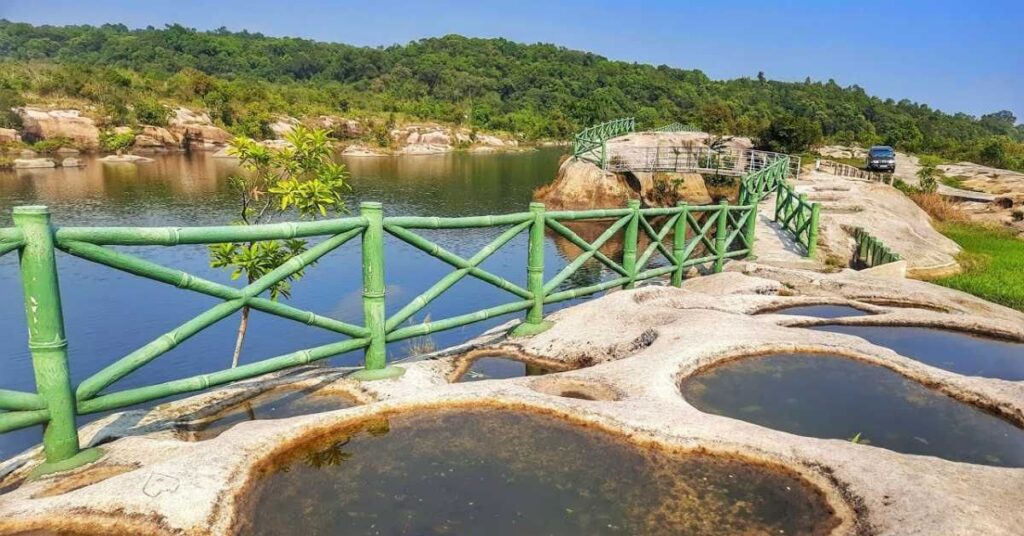
Mawlyngbna, a serene village nestled near Mawsynram, is a haven for eco-tourism enthusiasts. Surrounded by verdant hills and pristine rivers, the village offers a multitude of outdoor adventures. Trekkers can explore lush forests and discover hidden waterfalls, while kayaking on the tranquil Umkhakoi Reservoir provides a peaceful escape. Immerse yourself in Khasi culture by visiting sacred groves, where biodiversity conservation efforts intertwine with tradition. Mawlyngbna’s commitment to sustainability, evident in eco-friendly accommodations and community-based tourism, ensures a harmonious experience that preserves the region’s natural beauty while supporting local livelihoods.
Nohkalikai Falls:
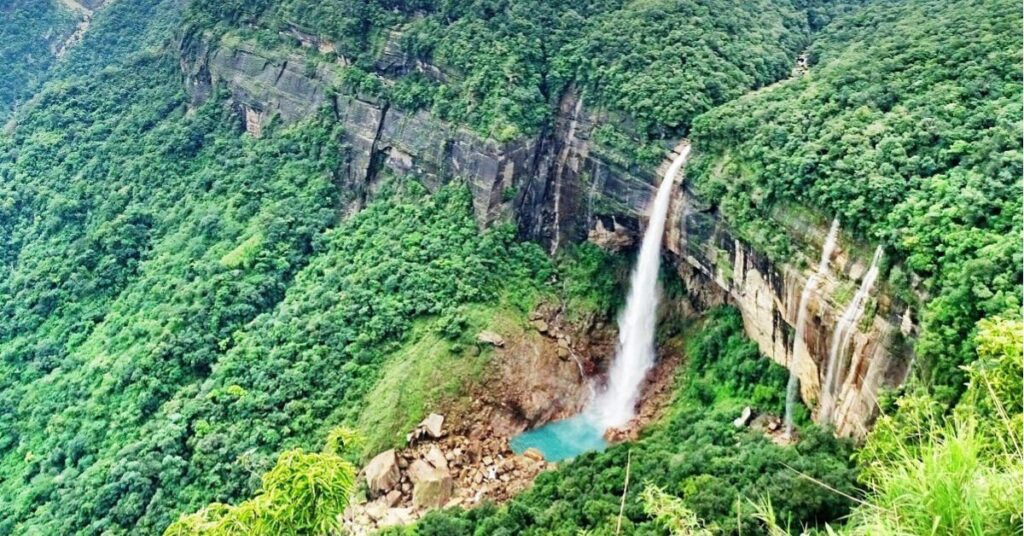
Nohkalikai Falls, near Cherrapunji, is a breathtaking spectacle and India’s tallest plunge waterfall. The water cascades dramatically over 1,100 feet into a vibrant turquoise pool below. Surrounded by mist-laden greenery, the falls are a photographer’s dream and a must-see for nature lovers. Trekkers can enjoy panoramic views of the falls and the surrounding valleys, creating an unforgettable experience of Meghalaya’s natural grandeur.
Sacred Groves:
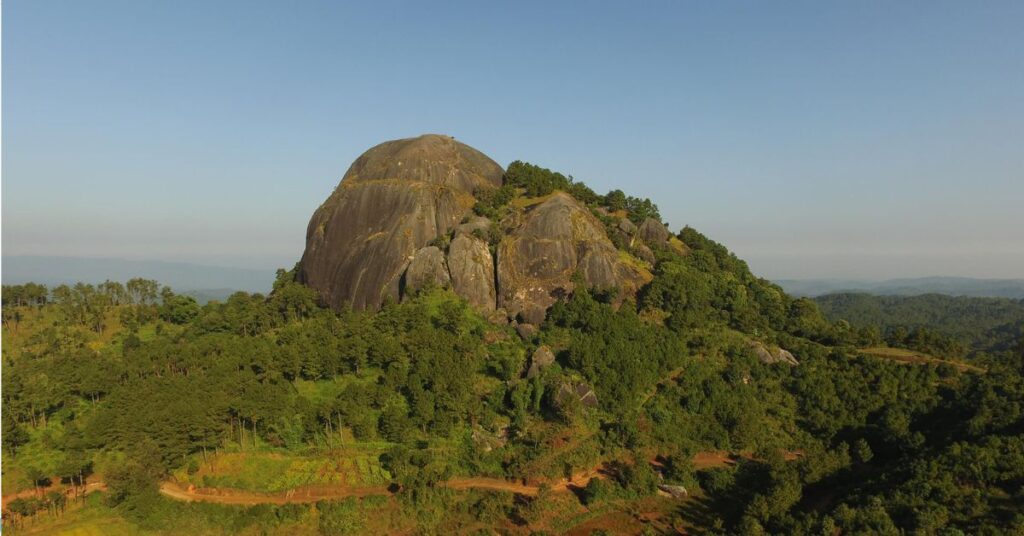
Meghalaya’s sacred groves near Mawsynram are living testaments to the harmonious coexistence of nature and culture. These ancient forests, meticulously preserved by local communities for centuries, are brimming with unique flora and fauna. As you wander along serene paths, you’ll encounter towering trees adorned with sacred offerings, remnants of rich Khasi traditions. These groves are not just ecological sanctuaries but also spiritual repositories, where every plant holds significance in folklore and traditional medicine. Exploring these sacred spaces offers a profound connection to Meghalaya’s cultural heritage and its unwavering commitment to environmental stewardship.
Thangkharang Park:
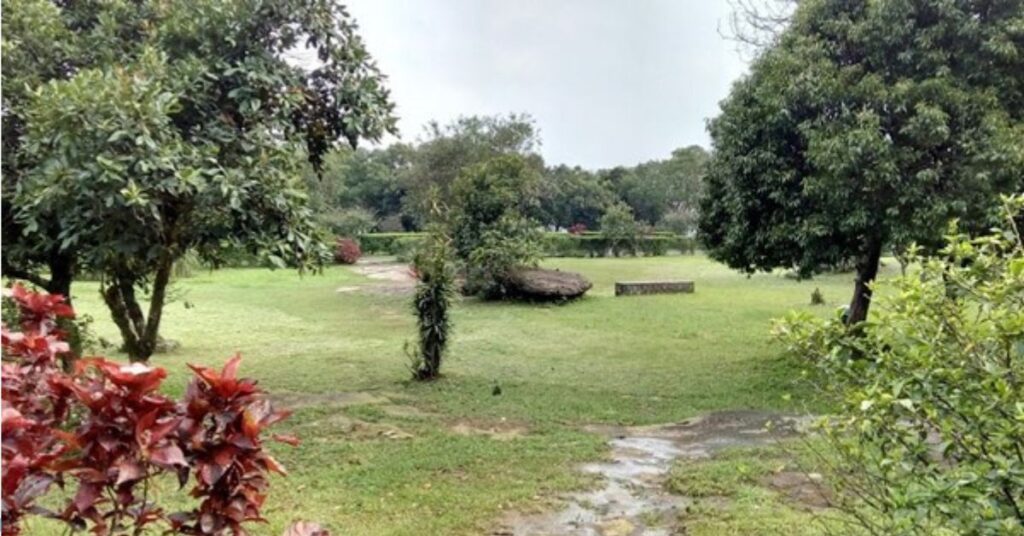
Thangkharang Park, perched above the Bangladesh plains near Cherrapunji, is a haven of breathtaking vistas and natural wonders. The park’s crown jewel is the Kynrem Falls, a majestic cascade plunging over 1,000 feet into the lush valley below. Visitors can relax amidst the park’s verdant surroundings, enjoying picnics while admiring the waterfall and the surrounding landscape. Several viewpoints within the park offer panoramic views of distant hills and the Bangladesh plains, creating a serene atmosphere perfect for unwinding and appreciating Meghalaya’s natural beauty.
Local Experiences:
Living Root Bridges: Trek to nearby villages like Nongriat to marvel at nature’s engineering marvels – the living root bridges, intricately woven from tree roots.
Mawsmai Cave: Embark on an underground adventure through Mawsmai Cave, where stunning stalactite and stalagmite formations illuminate the subterranean world.
Mawlyngbna Eco-Escape: Immerse yourself in nature at Mawlyngbna. Hike through lush forests, kayak on the serene Umkhakoi Reservoir, and explore sacred groves teeming with biodiversity.
Nohkalikai Falls: Witness the raw power of nature at Nohkalikai Falls, India’s tallest plunge waterfall. Hike to viewpoints for breathtaking panoramas of this natural wonder.
Sacred Groves: Discover the spiritual heart of Meghalaya in its ancient sacred groves near Mawsynram. Explore serene paths, learn about Khasi traditions, and appreciate the region’s commitment to conservation.
Thangkharang Park: Enjoy panoramic views of the Kynrem Falls and the Bangladesh plains from Thangkharang Park. Relax amidst nature and savor the tranquility.
Dawki River: Experience the magic of the crystal-clear Umngot River at Dawki. Boat on its transparent waters or zipline across, enjoying stunning views of the surrounding hills.
Khasi Cultural Immersion: Immerse yourself in Meghalaya’s rich culture by visiting Khasi villages. Interact with locals, savor traditional cuisine, and witness vibrant festivals like the Nongkrem Dance.
Travel tips:
Prepare for the Weather: Pack waterproof gear, sturdy shoes, and an umbrella as Mawsynram’s rainfall is legendary.
Navigate the Roads: Be prepared for winding roads, especially during the monsoon. Allow extra travel time and consider alternative routes if needed.
Secure Your Stay: Book accommodations in advance, particularly during peak season, to ensure availability and a comfortable base for your exploration.
Plan Your Transport: Opt for shared taxis or private cabs for flexible travel between Mawsynram, Shillong, and Cherrapunji.
Stay Weather-Aware: Check weather forecasts regularly and adjust your itinerary accordingly. Rainfall can impact outdoor activities and visibility.
Respect Local Customs: Honor local traditions and seek permission before entering sacred sites or participating in cultural events.
Prioritize Health: Carry essential medications and drink safe water to safeguard your health. Medical facilities might be limited in remote areas.
Protect the Environment: Practice responsible tourism by minimizing waste, supporting eco-friendly initiatives, and respecting wildlife and their habitats.
Manage Your Finances: Carry sufficient cash as ATM access might be limited. Check your mobile network coverage before departure.
Consider a Local Guide: Enhance your experience and support the local community by hiring a guide for treks or off-the-beaten-path exploration.
Conclusion
Mawsynram, Meghalaya, beckons adventurers to a realm of natural wonders and cultural richness. From the living root bridges to the depths of Mawsmai Cave, explore captivating landscapes shaped by nature’s artistry. Immerse yourself in the tranquility of sacred groves and witness the raw power of Nohkalikai Falls. Connect with warm Khasi hospitality and vibrant traditions. Whether you’re exploring lush rainforests or soaking in panoramic vistas, Mawsynram offers an unforgettable journey. Plan your adventure with Xplro.com and unlock the magic of this rain-kissed paradise.
FAQs
Why is Mawsynram famous?
- Mawsynram is renowned for being one of the wettest places on Earth, receiving exceptionally high annual rainfall that shapes its lush landscapes and vibrant ecosystem.
What is the ideal time to visit Mawsynram?
- The ideal time to visit Mawsynram is during the dry season from October to April when the weather is pleasant and suitable for outdoor activities.
How do you get to Mawsynram from Guwahati?
- You can reach Mawsynram from Guwahati by road, taking approximately 4-5 hours via private taxi or shared cab through scenic routes.
What are the main attractions in Mawsynram?
- Key attractions include living root bridges, Mawsmai Cave, Nohkalikai Falls, sacred groves, and Thangkharang Park offering panoramic views of the Kynrem Falls.
What activities can I do in Mawsynram during the monsoon season?
- During the monsoon, you can experience intense rainfall, trek to waterfalls like Nohkalikai Falls, and explore lush greenery and pristine rivers.
Are there any cultural experiences in Mawsynram?
- Yes, visitors can immerse themselves in Khasi culture by visiting local villages, participating in cultural festivals like Nongkrem Dance, and enjoying traditional cuisine.
What should I pack for a trip to Mawsynram?
- Pack waterproof clothing, sturdy footwear, umbrellas, and essentials like medications, as the region experiences heavy rainfall throughout the year.
Is there accommodation available in Mawsynram?
- Accommodation options in Mawsynram include guesthouses, homestays, and resorts. It’s advisable to book in advance, especially during peak tourist seasons.
What are the road conditions like in Mawsynram?
- Road conditions can be narrow and winding, particularly during the monsoon season. It’s recommended to check weather updates and travel advisories before embarking on your journey.
Can I visit Mawsynram as a day trip from Shillong?
- Yes, Mawsynram is about 60 kilometers south of Shillong, making it feasible for a day trip. Plan your itinerary to include key attractions and activities.
Are there any health precautions I should take in Mawsynram?
- Carry necessary medications and drink bottled or boiled water to avoid health issues. Medical facilities may be limited in remote areas.
What eco-friendly practices should I follow while visiting Mawsynram?
- Practice responsible tourism by disposing of waste properly, supporting local eco-friendly initiatives, and respecting wildlife and natural habitats.




